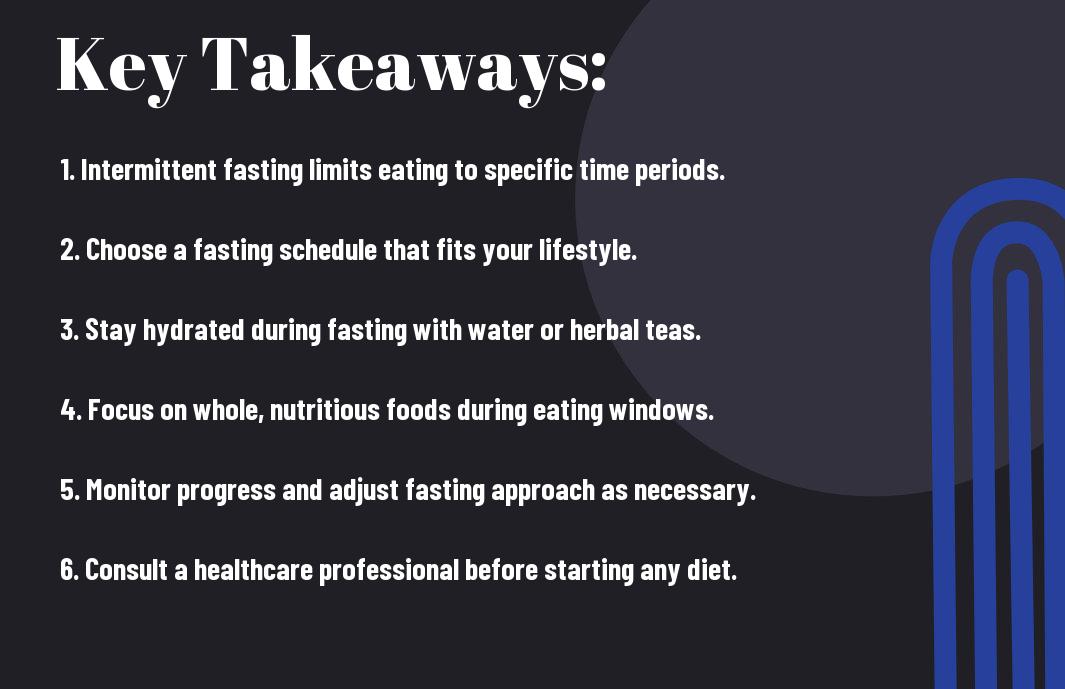There’s a growing interest in intermittent fasting as a simple yet effective method for weight loss. This guide will walk you through the fundamentals of intermittent fasting, including various methods, potential benefits, and tips to help you succeed on your journey. By understanding how to integrate fasting into your routine, you can make informed choices that support your weight loss goals while promoting overall health. Get ready to explore how this approach can fit into your lifestyle effectively.
Key Takeaways:
- Intermittent Fasting Protocols: Various methods are available such as the 16/8 method or the 5:2 diet, allowing flexibility to fit individual lifestyles.
- Health Benefits: Alongside weight loss, intermittent fasting can improve metabolic health, enhance brain function, and support cellular repair processes.
- Consistency and Patience: Successful weight loss through intermittent fasting requires a commitment to a schedule and may take time to see significant results.

What is Intermittent Fasting?
While many people associate fasting with deprivation, intermittent fasting is a structured approach that allows you to eat within set timeframes. It focuses not on what you eat, but rather when you eat, helping you regulate your calorie intake effortlessly. By incorporating fasting intervals into your routine, you may find it easier to lose weight and improve your overall health.
Definition and Overview
Beside being a popular weight loss strategy, intermittent fasting involves cycling between periods of eating and fasting. This eating pattern has gained traction for its flexibility and effectiveness, helping you manage cravings and lower overall caloric intake without strict dieting.
Popular Methods
Along with its flexibility, there are several popular methods of intermittent fasting, allowing you to choose one that fits your lifestyle. Common approaches include the 16/8 method, where you fast for 16 hours and eat during an 8-hour window, and the 5:2 diet, where you eat normally for five days and restrict calories on two non-consecutive days.
This variety allows you to customize your fasting experience. The 16/8 method is great for beginners as it simply involves skipping breakfast, while the 5:2 diet provides more freedom in daily eating. Other options include alternate day fasting and the eat-stop-eat method, which incorporates a full 24-hour fast once or twice a week. Ultimately, you can choose a method that aligns with your goals and daily routine, making it easier to integrate fasting into your life.
The Science Behind Intermittent Fasting
Some studies suggest that intermittent fasting can significantly influence your body’s mechanisms for weight management. By altering when you eat rather than what you eat, you may initiate a variety of metabolic changes that promote fat loss and improve overall health. Understanding these scientific principles can empower you to optimize your fasting approach for better results.
How It Affects Metabolism
The process of intermittent fasting can enhance your metabolism, primarily by increasing the levels of norepinephrine, a hormone that helps break down body fat. This increase mobilizes fat stores for energy, making it easier for your body to burn fat during fasting periods. Ultimately, this metabolic boost can aid in achieving your weight loss goals faster.
Hormonal Changes
After starting intermittent fasting, you may experience significant hormonal changes that can benefit your weight loss efforts. These changes include increases in growth hormone and improvements in insulin sensitivity, both of which help your body use fat more efficiently for energy. (Consider monitoring these changes to tailor your approach more effectively.)
Even small adjustments in your eating patterns can impact your hormone levels substantially. For instance, growth hormone levels can rise up to five-fold during fasting, promoting fat breakdown and muscle preservation. Improved insulin sensitivity also means that your body can better handle carbohydrates, reducing the likelihood of fat storage. (Investigating how these hormonal shifts affect your body can make your fasting experience more rewarding.)
Intermittent Fasting and Weight Loss
Now that you’re exploring the concept of intermittent fasting, it’s vital to understand how it can facilitate weight loss. By cycling between periods of eating and fasting, you’re likely to reduce your caloric intake and enhance your body’s ability to burn fat. This approach not only helps you shed pounds but can also lead to sustainable weight management and improved overall health. (Choosing the right fasting plan is vital for your success.)
Mechanisms for Weight Loss
At the core of intermittent fasting are several mechanisms that support weight loss. When you fast, your insulin levels drop, which promotes fat burning. Additionally, your body experiences increased levels of norepinephrine, a hormone that enhances fat breakdown. This means that your body becomes more efficient at using stored fat for energy, ultimately contributing to weight loss. (Implementing a structured eating plan is important to maximize these effects.)
Benefits Beyond Weight Loss
With intermittent fasting, you may experience advantages that extend beyond just shedding pounds. Many individuals report increased energy levels, improved focus, and better metabolic health as byproducts of adopting this eating pattern. These benefits can significantly enhance your day-to-day life and provide motivation to stick to your fasting routine. (Considering these advantages can help you stay committed to your goals.)
Even if weight loss is your primary goal, understanding the broader benefits of intermittent fasting can be motivating. Studies suggest that this approach may promote longevity, enhance heart health, and reduce inflammation in your body. These potential improvements in health can lead to a better quality of life, making intermittent fasting a valuable option to consider in your journey. (Evaluating overall health improvements can encourage you to embrace this lifestyle change.)

Getting Started with Intermittent Fasting
Once again, commenceing on your intermittent fasting journey can initially seem daunting, but it is entirely manageable with the right approach. Start by familiarizing yourself with different fasting schedules and understanding the benefits they can bring to your weight loss goals. Consider your lifestyle, daily routine, and personal preferences to set a successful groundwork for your intermittent fasting experience.
Choosing the Right Method for You
Method selection is vital; there are several intermittent fasting methods available, such as the 16/8 or 5:2 methods. (Finding a method that aligns with your lifestyle will enhance your chances of sticking with it.) Evaluate how each method fits with your daily life to ensure sustainability and success.
Tips for a Smooth Transition
Above all, transitioning smoothly into intermittent fasting can significantly impact your experience. (Gradual adjustments may make the adaptation easier.) Consider these tips for a smoother change:
- Start with shorter fasting windows.
- Stay hydrated during fasting periods.
- Listen to your body and adapt as needed.
- Focus on healthy meals during eating windows.
- Seek support if needed.
The key is to find what works best for you as you adjust to this new routine.
In fact, being mindful of your food choices and managing your eating patterns will enhance your overall experience with intermittent fasting. (A well-balanced diet can make fasting periods more manageable.) Keep these strategies in mind:
- Prepare your meals in advance.
- Incorporate nutrient-dense foods.
- Track your progress over time.
- Stay accountable through community support.
- Be patient with your body as it adjusts.
The reward for your effort could be significant improvements in your weight loss journey.
Common Challenges and Solutions
After starting your intermittent fasting journey, you may encounter some challenges that can hinder your progress. It’s normal to experience initial obstacles such as hunger, social pressures, and confusion about meal planning. However, these challenges can be overcome with the right mindset and strategies to keep you focused on your weight loss goals.
Dealing with Hunger and Cravings
To manage hunger and cravings effectively, it’s important to stay hydrated and opt for nutrient-dense foods during your eating windows. (Choosing foods rich in fiber and protein can help you feel fuller for longer.) You can also distract yourself with light activities or hobbies to navigate through intense urges to eat.
Maintaining Nutrition During Fasting
Common issues arise with ensuring you get adequate nutrition while fasting. This often leads to imbalances that can affect your energy levels and overall health. It’s important to focus on whole, nutrient-dense foods during your eating periods to provide your body with the vitamins and minerals it needs to thrive.
Challenges like meal prep and understanding what to eat can make maintaining nutrition daunting. To tackle this, consider planning your meals ahead of time and creating a balanced plate combining lean proteins, healthy fats, and plenty of vegetables. This proactive approach will ensure you are not only adhering to your fasting schedule but also nourishing your body effectively.
Tracking Progress and Staying Motivated
Despite the challenges that come with a new diet, tracking your progress can keep you motivated and on track. Regularly monitoring your weight, measurements, and how your clothes fit can provide tangible proof of your efforts, making it easier to stay committed to your intermittent fasting journey. Celebrate the small victories along the way, as they add up to significant achievements over time, reinforcing your dedication to weight loss success.
Measuring Success
Around your intermittent fasting journey, it’s necessary to measure success through various metrics beyond just the scale. Consider evaluating your energy levels, mood, and overall health improvements. These indicators can help you gauge the effectiveness of your fasting strategy and give you a broader perspective on your progress.
Setting Realistic Goals
About setting realistic goals, it’s important to establish achievable targets that align with your lifestyle and preferences. Aim for incremental changes rather than drastic weight loss, which can lead to frustration. By focusing on specific, measurable, and time-bound objectives, you’re more likely to maintain motivation and build healthy habits that support your intermittent fasting journey.
A good approach is to set goals that are specific to your situation. For instance, instead of aiming to lose a large number of pounds quickly, consider setting a goal to lose 1-2 pounds per week. Break your main goal down into smaller milestones and reward yourself for reaching each one. By doing so, you create a series of successes that can help sustain your motivation and commitment, making your intermittent fasting journey more enjoyable and manageable.
To wrap up
On the whole, embracing intermittent fasting offers you a practical and flexible approach to weight loss. By understanding the various methods and aligning them with your lifestyle, you can effectively enhance your results. Consistency and mindful eating will significantly contribute to your journey. As you familiarize yourself with the process, you’ll find that intermittent fasting can be a sustainable way to achieve your health goals. Stay committed, stay informed, and watch as your dedication yields successful outcomes.
FAQ
Q: What is intermittent fasting and how does it aid in weight loss?
A: Intermittent fasting is an eating pattern that cycles between periods of fasting and eating. It doesn’t dictate which foods to eat but rather when you should eat them. This approach can help with weight loss by reducing calorie intake and potentially increasing metabolic rate. During fasting periods, your body shifts its energy source from glucose to stored fat, which can lead to weight loss over time. Additionally, intermittent fasting may improve insulin sensitivity, making it easier for your body to use stored fat for energy.
Q: How do I get started with intermittent fasting as a beginner?
A: Starting intermittent fasting can be simple. Begin by choosing a method that fits your lifestyle, such as the 16/8 method, where you fast for 16 hours and eat within an 8-hour window. Start gradually; for example, if you’re used to eating breakfast early, you might push your first meal to 10 AM and have your last meal by 6 PM. Focus on nourishing foods during your eating windows, which can help maintain your energy levels and reduce cravings. Staying hydrated is also important, so drink plenty of water throughout the day, even during fasting periods.
Q: Are there any side effects or considerations for intermittent fasting?
A: Some individuals may experience side effects when starting intermittent fasting, including hunger, fatigue, or irritability, especially during the initial adjustment period. These symptoms often subside as your body adapts to the new eating pattern. It’s important to listen to your body and adjust as needed. Intermittent fasting may not be suitable for everyone, including those with certain health conditions or those who are pregnant or breastfeeding. Consulting with a healthcare provider before beginning any fasting regimen is advisable to ensure it aligns with your health goals and needs.









Reply